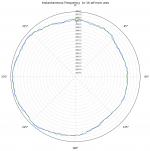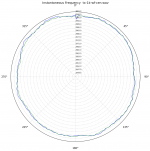Neat, JP. But unavailable. You'd still need a micro threaded thing to adjust the LP to be a really good tolerance.
Bill, if your LP can easily move then it probably doesn't sound as good as it could. Touching the LP while it spins would be better to stop the platter than have the LP move at all.
Define easily. It's a cork or felt mat. It can move. The carbon fibre brush will however stop the deck without slipping the record.
I have a felt mat and sometimes center the record by gently touching the edge while watching the tonearm movement. It works but an automatic way would be nice.
I was long thinking to use the 0.555 Hz signal filtered out from the RIAA stage as a signal source for a mechanical device that gently push the record into position. But I have no idea how such a device would look like. A semi-automatic way would be to display the signal (as a scope) and then use a manual centering device such as that used with the Simply Black record player.

I was long thinking to use the 0.555 Hz signal filtered out from the RIAA stage as a signal source for a mechanical device that gently push the record into position. But I have no idea how such a device would look like. A semi-automatic way would be to display the signal (as a scope) and then use a manual centering device such as that used with the Simply Black record player.

Imho there are 4solutions:
a) Get a well calibrated Naka TX 1000 Turntable , compensating THIS issue
b) accept it like it is
c) throw the record in the garbage
d) get another record from the same musician and try your luck
Few records will perfectly place with your spindle. They're cut extremely precise, but the hole and outer edge are not. It sounds better when centered... No one gets into this hobby because they hate all the details and small things that can be done to improve sound.
Bill, I recommend a rubber mat piece under cork. The combo actually works extremely well. You may have to raise the arm, but it stops all slippage, couples the LP better, but reduces some deeper vibrations.
Rubber mat and Xerxes do not go well together. I have NO SLIPPAGE. We brits like felt mats and anyway. I have a Kenwood DD with a rubber mat if I am in a rubbery mood.
Can't see how that centering device is supposed to work.
The center spindle is only 5 mm and the device has a conical shape and what I've heard slightly off-center hole that fits the spindle. So by turning it you change the centering of the record (perhaps +/- 0.5 mm). It has its limits but since most if not all records are more or less off-center you can at least make most records better. Once you found the best setting you could also mark on the record which position the device should have (and for each side, which can differ for the same record).
(It could be that it is only conical shape, but the above is what I've heard and makes it a bit special.)
Wouldn't a low compliance stylus somewhat negate the problems of minor offcenter record ? Or probably more tracking force ? if so, one can have extra headshell plus cartridge for occasional offcenter record listening.
OK understood.
I was thinking more on the lines of unwanted frequency modulations and uneven bias of offcenter records. How much difference in pitch it makes ? most of the turntables dont have accurate speed anyway.
I was thinking more on the lines of unwanted frequency modulations and uneven bias of offcenter records. How much difference in pitch it makes ? most of the turntables dont have accurate speed anyway.
OK understood.
I was thinking more on the lines of unwanted frequency modulations and uneven bias of offcenter records. How much difference in pitch it makes ? most of the turntables dont have accurate speed anyway.
Please refer to the Nakamichi video. It's pretty substantial. I think it's more audible than most TT's minor speed fluctuations by far. In fact some people won't listen to piano on vinyl because the pitch is all wrong.
Seems like a hole in the market!
I see what you did there!
Please refer to the Nakamichi video. It's pretty substantial. I think it's more audible than most TT's minor speed fluctuations by far. In fact some people won't listen to piano on vinyl because the pitch is all wrong.
This video shows how it works a bit clearer: YouTube
I haven't validated the math:
- from: How To Listen to Records: The Nakamichi TX-1000 TurntableI continue with my musical reactions in detail, let's think about numbers for a moment. Suppose we are listening to a groove that is, say, 75 mm from the center of the record; typically, this is still in the music groove region, but near the end of it. (Seventy-five millimeters is about three inches.) Since the record goes around once in 1/(33 1/3) minutes = 1.8 seconds, the velocity of this groove past the stylus is 2 pi (75mm)/1.8 sec. which equals 261.8 mm/sec.
Now suppose the record is 0.5 mm off center. (This is the limit of the correcting motion of the Nakamichi TX1000. Records further off-center than that have to be roughly hand centered before the TX1000 is applied. Most records that do not have badly worn spindle holes meet this standard of 0.5 mm.) Then when we are hearing the part of the 75 mm groove that is furthest from the platter center, the effective radius of the groove is 75.5 mm and the velocity goes up to 263.5 mm/sec. At the closest part of the groove, the radius is effectively 74.5 mm and the velocity goes down to 260.1. The ratio between the maximum and minimum velocities is 75.5/74.5 = 1.0134. Thus the pitch of a note recorded in this groove is a little more than 1.3 percent higher at the part farthest from the platter center than it is at the part closest. In another viewpoint, the wow is ±0.66 percent. Proportionately, smaller center errors give smaller pitch wow, with .25 mm giving about 0.33 percent, 0.1 mm giving .13 percent, etc. Smaller groove radii would give larger wow percentage (inverse proportion) for a given off-centeredness. Off-center wow is worst at the end of the side.
A usually accepted standard for audibility of wow is 0.1 percent. This of course varies from person to person. The pitch discrimination level for A/B matching can be as low as 0.01 percent in people highly sensitive to pitch.4 This is of course a different, probably more sensitive kind of pitch audibility than wow, but in fact the repeated periodic pitch variations of off-center wow are seemingly quite close in nature to the A/B test.
Last, two polar plots, before and after centering, attached. IIRC, the error on this record was ~0.15mm. I still prefer the SP-10MK3 for ergonomics, but when archiving I use the TX-1000. Once I paid attention to the errors they became impossible to ignore, and the majority of records I've played on the Nak have rather meaningful errors.
Attachments
The issue is that although angular velocity is constant, tangential velocity depends on the groove radius, which is periodically changing due to off-centered hole.Wouldn't a low compliance stylus somewhat negate the problems of minor offcenter record ? Or probably more tracking force ? if so, one can have extra headshell plus cartridge for occasional offcenter record listening.
Some use a reamer to enlarge the 7.3 mm (0.286") hole to let's say 7.5 and manually poking around the disc by trial-and-error until the cartridge seems steady.
To me it's very obvious in the videos about the difference in sound. I recommend listening to it not to know how it's done, but rather how significant the little tiny movement is on what you hear.
I recommend listening to it not to know how it's done, but rather how significant the little tiny movement is on what you hear.
Not to me, even though as JP will testify I spent hours of my own time helping to make this tool to observe the effect. I just can't get ito the mode of listening for problems rather than the music.
I don’t hear a problem, I just hear how much better the Nakamichi sounds once it is adjusted to center.
But as I said earlier, some people don’t really notice pitch.
But as I said earlier, some people don’t really notice pitch.
- Status
- Not open for further replies.
- Home
- Source & Line
- Analogue Source
- vinyl record hole off center

